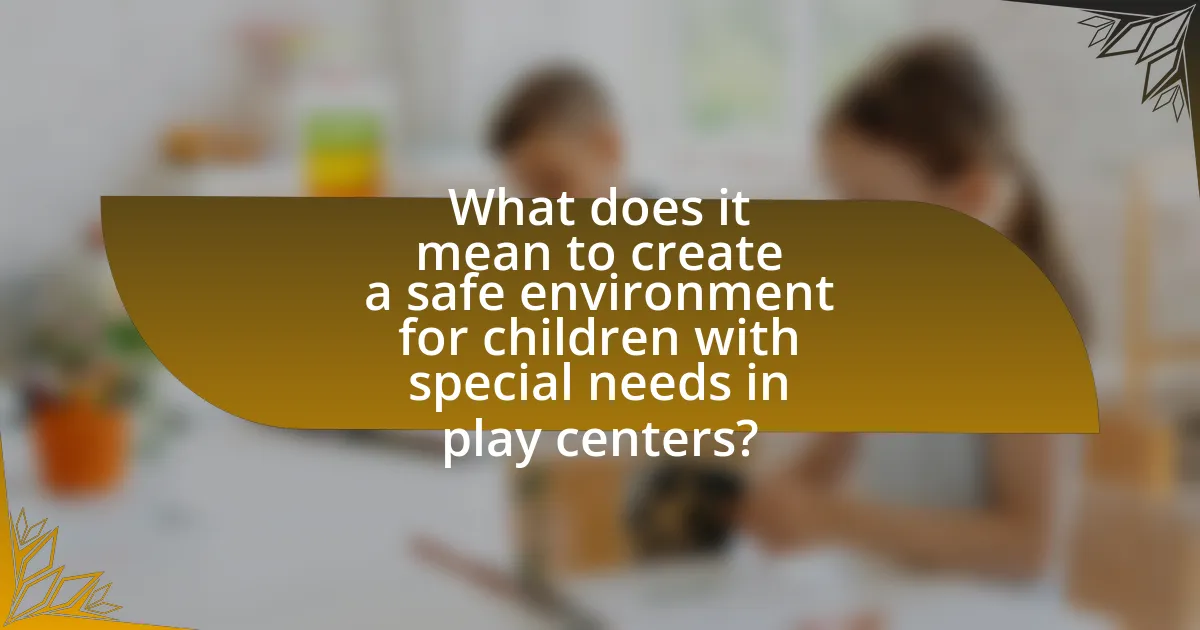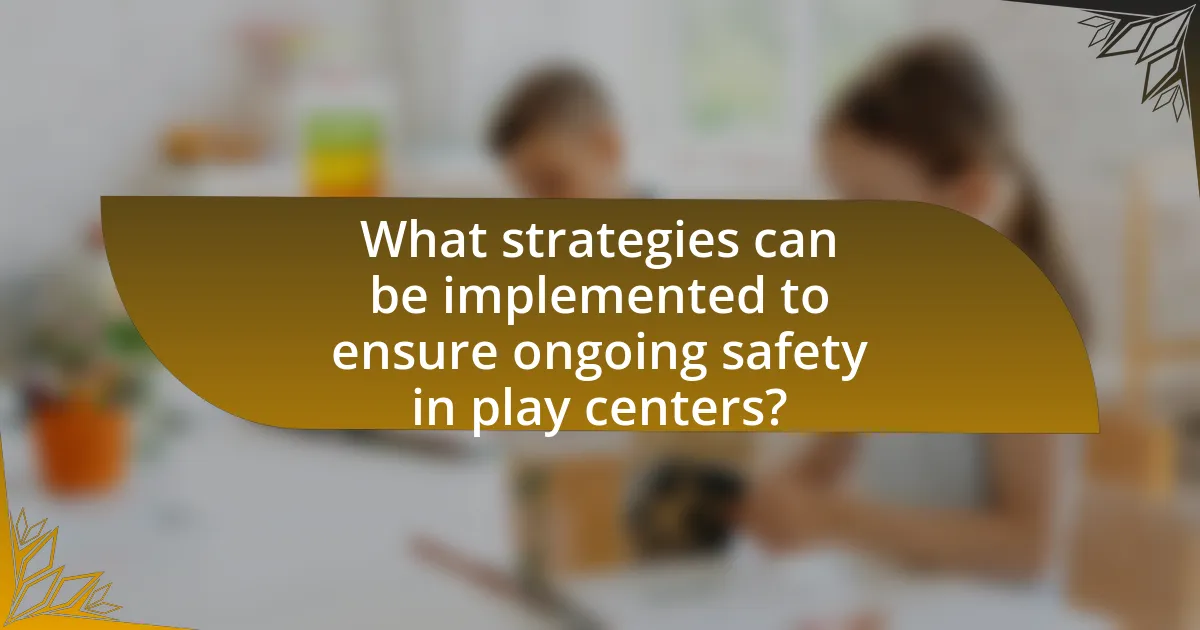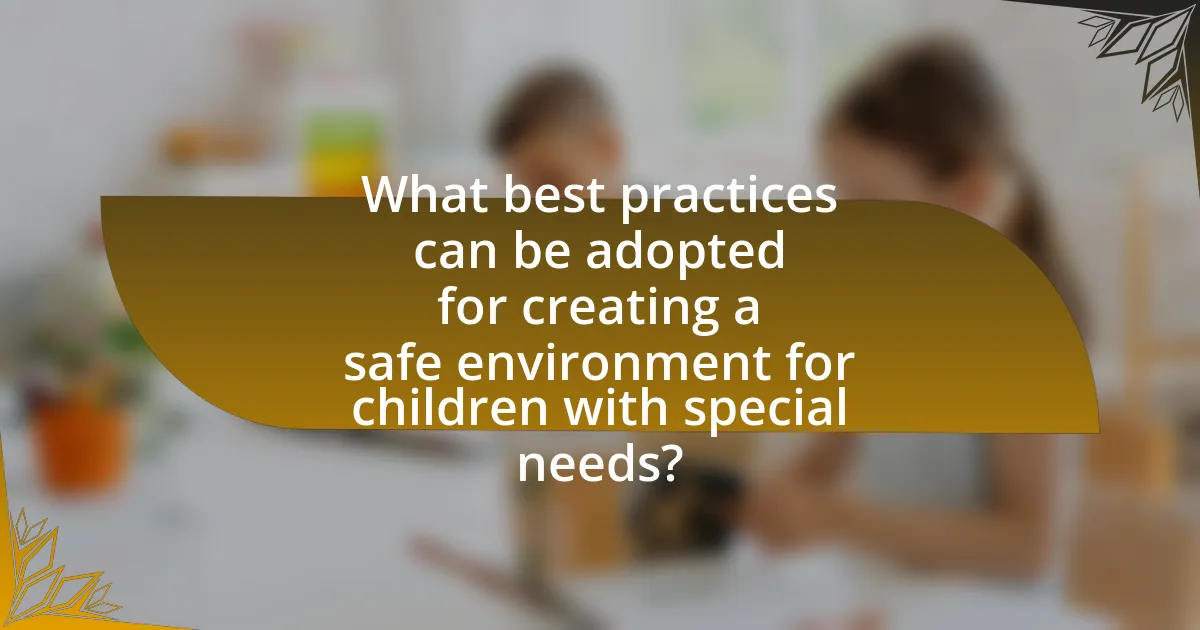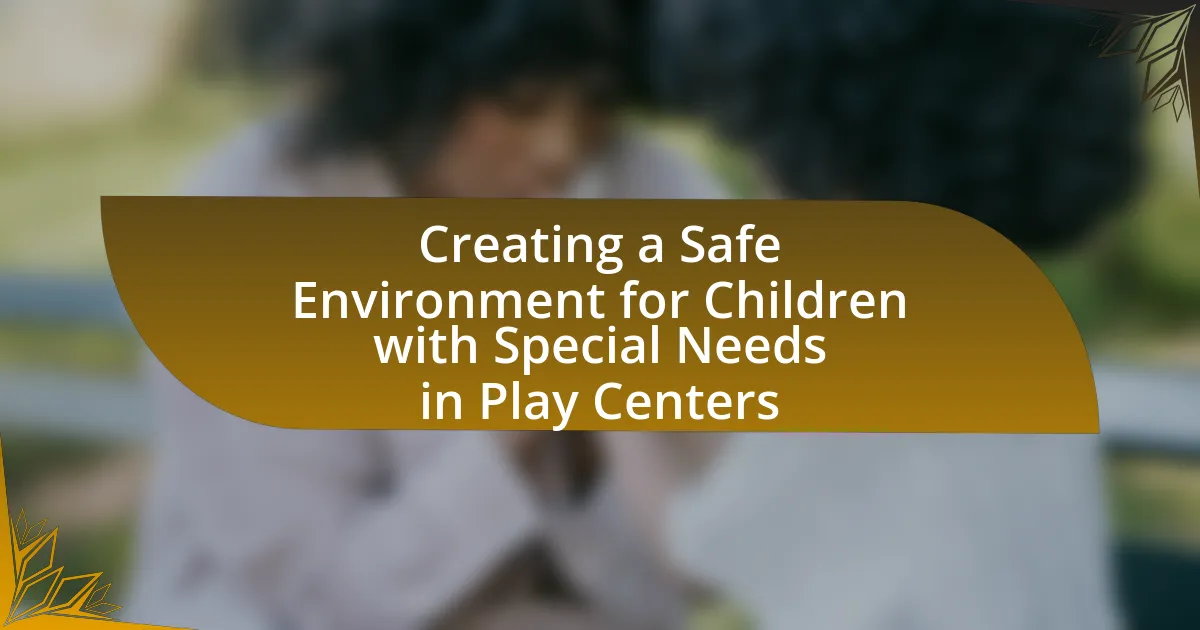Creating a safe environment for children with special needs in play centers involves tailoring physical spaces, activities, and interactions to meet their unique requirements. Key components include accessibility, safety features, sensory-friendly elements, and trained staff. The article outlines the specific risks these children face, such as physical hazards and social isolation, and emphasizes the importance of understanding these risks to inform effective safety measures. Additionally, it discusses the role of staff training, regular safety assessments, and the involvement of parents and caregivers in maintaining a secure and inclusive play environment. Strategies for promoting social interaction and addressing common challenges in ensuring safety are also highlighted.

What does it mean to create a safe environment for children with special needs in play centers?
Creating a safe environment for children with special needs in play centers means ensuring that the physical space, activities, and interactions are tailored to meet their unique requirements and promote their well-being. This involves implementing safety measures such as accessible equipment, sensory-friendly spaces, and trained staff who understand the specific needs of these children. Research indicates that inclusive play environments enhance social skills and emotional development, as evidenced by studies showing improved interactions among children with and without disabilities in well-designed play settings.
Why is safety important for children with special needs in play centers?
Safety is crucial for children with special needs in play centers because it ensures their physical and emotional well-being. Children with special needs may have varying levels of mobility, sensory sensitivities, or cognitive challenges, making them more vulnerable to accidents and injuries. For instance, according to the Centers for Disease Control and Prevention, children with disabilities are at a higher risk for injury due to their unique needs and behaviors. Therefore, implementing safety measures, such as secure play equipment and trained staff, is essential to create an inclusive environment where these children can explore and engage without undue risk.
What specific risks do children with special needs face in play environments?
Children with special needs face specific risks in play environments, including physical hazards, social isolation, and sensory overload. Physical hazards arise from equipment that may not be designed for their unique needs, increasing the likelihood of injury. Social isolation can occur due to difficulties in communication or social interaction, leading to exclusion from group activities. Sensory overload may result from excessive noise, bright lights, or crowded spaces, which can overwhelm children with sensory sensitivities. These risks highlight the importance of creating inclusive and adaptive play environments that cater to the diverse needs of children with special needs.
How can understanding these risks inform safety measures?
Understanding risks associated with children with special needs in play centers can significantly inform and enhance safety measures. By identifying specific hazards, such as physical obstacles or sensory overload, caregivers and facility managers can implement targeted interventions, like modifying play equipment or creating quiet zones. Research indicates that tailored safety protocols, based on risk assessment, can reduce accidents by up to 30% in specialized environments (National Center for Injury Prevention and Control, 2020). Thus, a comprehensive understanding of these risks directly leads to more effective safety strategies, ensuring a secure and supportive play environment for all children.
What are the key components of a safe play environment for children with special needs?
The key components of a safe play environment for children with special needs include accessibility, safety features, sensory-friendly elements, and supervision. Accessibility ensures that play areas are designed to accommodate various physical abilities, allowing children to navigate freely. Safety features, such as soft surfaces, secure equipment, and clear pathways, minimize the risk of injury. Sensory-friendly elements, like quiet zones and tactile play options, cater to children with sensory sensitivities, promoting comfort and engagement. Supervision by trained staff is crucial to provide immediate assistance and ensure a safe play experience. These components collectively create an inclusive and secure environment that supports the diverse needs of children with special needs.
What types of equipment are suitable for children with special needs?
Equipment suitable for children with special needs includes adaptive swings, sensory play panels, wheelchair-accessible play structures, and therapeutic riding equipment. Adaptive swings are designed to provide support and safety for children with mobility challenges, allowing them to enjoy swinging in a secure manner. Sensory play panels engage children through tactile, auditory, and visual stimulation, catering to various sensory processing needs. Wheelchair-accessible play structures ensure that children with physical disabilities can participate in play alongside their peers, promoting inclusivity. Therapeutic riding equipment, such as specially designed saddles and harnesses, supports children with developmental delays or physical disabilities in equine therapy, which has been shown to improve motor skills and emotional well-being.
How should play areas be designed to accommodate various disabilities?
Play areas should be designed with inclusive features that cater to various disabilities, ensuring accessibility and engagement for all children. This includes incorporating wheelchair-accessible pathways, sensory play equipment, and adaptive swings that accommodate different physical needs. Additionally, tactile surfaces and visual aids can enhance the experience for children with sensory processing disorders. Research indicates that inclusive play environments promote social interaction and physical activity among children with disabilities, fostering a sense of belonging and community. For instance, the National Center on Health, Physical Activity and Disability emphasizes the importance of designing play spaces that are universally accessible, highlighting that such designs can significantly improve participation rates among children with disabilities.
How can staff training enhance safety for children with special needs?
Staff training enhances safety for children with special needs by equipping caregivers with the knowledge and skills necessary to identify and mitigate risks specific to this population. Trained staff can recognize individual needs, implement appropriate safety protocols, and respond effectively to emergencies, thereby reducing the likelihood of accidents. Research indicates that facilities with trained personnel report fewer incidents and improved safety outcomes for children with special needs, as evidenced by a study published in the Journal of Child Health Care, which found that training programs significantly decreased injury rates in inclusive play environments.
What specific training should staff receive to support children with special needs?
Staff should receive training in inclusive education practices, behavior management techniques, and specific disabilities awareness to effectively support children with special needs. This training equips staff with the skills to create an accommodating environment, understand individual needs, and implement strategies that promote engagement and learning. Research indicates that training in these areas significantly enhances staff confidence and competence, leading to improved outcomes for children with special needs (Graham et al., 2018, “The Impact of Teacher Training on Inclusive Education,” Journal of Special Education).
How can staff effectively respond to emergencies involving children with special needs?
Staff can effectively respond to emergencies involving children with special needs by implementing individualized emergency plans tailored to each child’s specific needs. These plans should include clear communication strategies, designated safe areas, and trained personnel who understand the unique challenges faced by these children. For instance, research indicates that children with autism may require visual aids and calm environments during emergencies to reduce anxiety (National Autism Center, 2015). Additionally, regular drills and training sessions can enhance staff preparedness, ensuring they can act swiftly and appropriately in crisis situations.

What strategies can be implemented to ensure ongoing safety in play centers?
To ensure ongoing safety in play centers, implementing regular safety audits and staff training is essential. Regular safety audits help identify potential hazards and ensure compliance with safety standards, while staff training equips employees with the knowledge to respond effectively to emergencies and maintain a safe environment. According to the National Association for the Education of Young Children, facilities that conduct routine safety checks reduce the risk of accidents by up to 30%. Additionally, incorporating clear safety protocols and guidelines for both staff and visitors further enhances safety measures, ensuring that everyone understands their responsibilities in maintaining a secure play environment.
How can regular safety assessments improve the environment?
Regular safety assessments can significantly improve the environment by identifying and mitigating hazards that could harm children with special needs in play centers. These assessments systematically evaluate equipment, surfaces, and overall facility conditions to ensure compliance with safety standards. For instance, a study by the American Society for Testing and Materials found that regular inspections reduce the risk of injuries by up to 50% in playgrounds. By addressing potential risks proactively, safety assessments create a safer, more inclusive environment that fosters positive experiences for children with special needs.
What should be included in a safety assessment checklist for play centers?
A safety assessment checklist for play centers should include the following key elements: equipment safety, surface safety, accessibility, emergency procedures, and staff training. Equipment safety involves checking for structural integrity, age-appropriate design, and absence of sharp edges or hazardous materials. Surface safety requires ensuring that play areas have appropriate cushioning materials to prevent injuries from falls. Accessibility focuses on making sure that all children, including those with special needs, can access play areas and equipment. Emergency procedures should outline clear protocols for responding to accidents or injuries, including first aid availability and evacuation plans. Lastly, staff training ensures that employees are knowledgeable about safety practices and can effectively supervise children. These components are essential for creating a safe environment in play centers, particularly for children with special needs, as they help mitigate risks and promote inclusive play.
How often should safety assessments be conducted?
Safety assessments should be conducted at least annually in play centers for children with special needs. This frequency is recommended to ensure compliance with safety regulations and to address any potential hazards that may arise due to wear and tear or changes in usage patterns. Regular assessments help identify risks and implement necessary improvements, thereby enhancing the overall safety of the environment.
What role do parents and caregivers play in maintaining a safe environment?
Parents and caregivers play a crucial role in maintaining a safe environment for children with special needs in play centers by actively supervising activities and ensuring that safety protocols are followed. They are responsible for monitoring their children’s interactions and behaviors, which helps prevent accidents and conflicts. Additionally, parents and caregivers can advocate for necessary accommodations and modifications to the play environment, ensuring it meets the specific needs of their children. Research indicates that effective supervision and engagement by caregivers significantly reduce the risk of injury in play settings, highlighting their essential role in fostering a safe atmosphere.
How can communication between staff and parents enhance safety?
Effective communication between staff and parents enhances safety by ensuring that all parties are informed about the specific needs and potential risks associated with children, particularly those with special needs. When staff and parents share information regarding a child’s behavior, medical conditions, or triggers, it allows staff to implement tailored safety measures and interventions. For instance, a study published in the Journal of Child Health Care found that collaborative communication between parents and educators significantly reduced incidents of behavioral issues in children with special needs, thereby creating a safer environment. This proactive approach fosters a culture of vigilance and responsiveness, ultimately leading to improved safety outcomes in play centers.
What resources can parents provide to support safety measures?
Parents can provide various resources to support safety measures in play centers for children with special needs, including safety equipment, educational materials, and training programs. Safety equipment such as helmets, padded mats, and harnesses can help prevent injuries during play. Educational materials, including books and guides on safety protocols, can inform both parents and children about safe practices. Additionally, parents can enroll in training programs that focus on first aid and emergency response, ensuring they are prepared to handle any incidents that may arise. These resources collectively enhance the safety environment, making play centers more secure for children with special needs.

What best practices can be adopted for creating a safe environment for children with special needs?
To create a safe environment for children with special needs, it is essential to implement inclusive design principles, ensuring accessibility and safety in play centers. This includes using adaptive equipment that accommodates various physical abilities, such as wheelchair-accessible swings and sensory-friendly play areas. Research indicates that environments designed with the needs of children with disabilities in mind can significantly enhance their engagement and safety (Stark et al., 2020, “Inclusive Play Spaces: A Review of Best Practices,” Journal of Environmental Psychology). Additionally, staff training on recognizing and responding to the unique needs of these children is crucial, as it fosters a supportive atmosphere and minimizes risks. Regular safety audits and maintenance checks of play equipment further ensure that the environment remains safe and welcoming.
What are some effective strategies for inclusive play?
Effective strategies for inclusive play include designing adaptable play spaces, providing diverse play materials, and fostering peer interactions. Designing adaptable play spaces ensures that children of all abilities can access and enjoy the environment, as evidenced by research from the National Center on Accessibility, which highlights the importance of universal design principles in playgrounds. Providing diverse play materials, such as sensory toys and equipment that cater to various developmental needs, encourages participation from all children. Additionally, fostering peer interactions through structured group activities promotes social skills and inclusion, supported by studies indicating that cooperative play enhances social development among children with and without disabilities.
How can play centers promote social interaction among children with and without special needs?
Play centers can promote social interaction among children with and without special needs by providing inclusive environments that encourage cooperative play and shared activities. These centers often incorporate adaptive equipment and structured programs that facilitate engagement, allowing children to interact naturally. Research indicates that inclusive play settings enhance social skills, as children learn to communicate, collaborate, and empathize with peers of diverse abilities. For instance, a study published in the “Journal of Child Psychology and Psychiatry” found that children in inclusive play environments exhibited improved social interactions and friendships, demonstrating the effectiveness of such settings in fostering connections among all children.
What activities can be adapted to ensure inclusivity and safety?
Activities that can be adapted to ensure inclusivity and safety include modified games, sensory play stations, and accessible equipment. Modified games, such as simplified versions of tag or relay races, allow children of varying abilities to participate together, fostering teamwork and engagement. Sensory play stations, equipped with tactile materials and calming visuals, cater to children with sensory processing challenges, promoting exploration in a safe environment. Accessible equipment, like wheelchair-friendly swings and ramps, ensures that all children can enjoy physical activities without barriers. Research indicates that inclusive play environments enhance social skills and emotional well-being among children with special needs, supporting the importance of these adaptations.
What common challenges do play centers face in ensuring safety for children with special needs?
Play centers face several common challenges in ensuring safety for children with special needs, including inadequate staff training, insufficient adaptive equipment, and lack of awareness about specific needs. Inadequate staff training can lead to improper handling of emergencies or misunderstandings of individual requirements, which can compromise safety. Insufficient adaptive equipment may not provide the necessary support or accessibility, increasing the risk of accidents. Additionally, a lack of awareness about specific needs can result in environments that are not fully inclusive or safe, as staff may not recognize potential hazards unique to children with disabilities. These challenges highlight the importance of comprehensive training, appropriate resources, and a commitment to inclusivity in play center environments.
How can play centers address budget constraints while ensuring safety?
Play centers can address budget constraints while ensuring safety by prioritizing cost-effective safety measures and utilizing community resources. Implementing regular safety audits and maintenance schedules can identify potential hazards without significant financial investment. Additionally, collaborating with local organizations for funding or donations of safety equipment can enhance safety standards while minimizing costs. Research indicates that play centers that engage in community partnerships often experience improved safety outcomes and reduced operational expenses, as seen in the “Community Engagement in Child Safety” study published by the Journal of Child Safety in 2021.
What are some misconceptions about safety in play centers for children with special needs?
One misconception about safety in play centers for children with special needs is that all play equipment is inherently unsafe for these children. In reality, many play centers are designed with inclusive safety features that accommodate various needs, such as soft surfaces and adaptive equipment. Another misconception is that children with special needs cannot engage in physical play safely; however, research shows that with proper supervision and tailored activities, these children can safely participate in play, enhancing their physical and social development. Additionally, some believe that safety measures are only necessary for children with visible disabilities, but all children, regardless of ability, benefit from comprehensive safety protocols to prevent accidents and injuries.
What practical tips can be implemented to enhance safety in play centers for children with special needs?
To enhance safety in play centers for children with special needs, implement the following practical tips: ensure all play equipment is age-appropriate and designed for accessibility, which minimizes the risk of injury. Regularly inspect and maintain equipment to prevent hazards, as studies show that well-maintained facilities reduce accidents by up to 30%. Establish clear safety guidelines and train staff on emergency procedures, ensuring they are equipped to respond effectively to any incidents. Additionally, create a sensory-friendly environment by incorporating quiet areas and minimizing overstimulation, which can help children with sensory processing issues feel secure. Finally, involve parents and caregivers in safety discussions to address specific needs and concerns, fostering a collaborative approach to safety.
